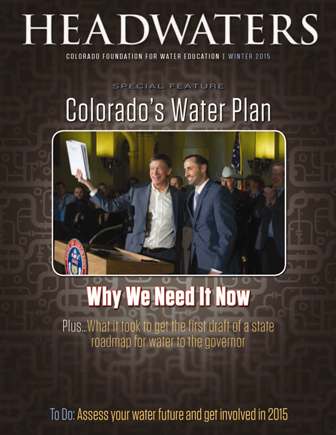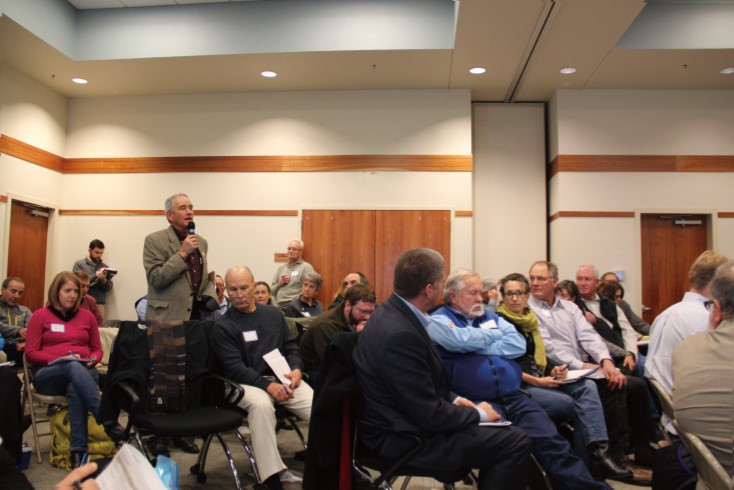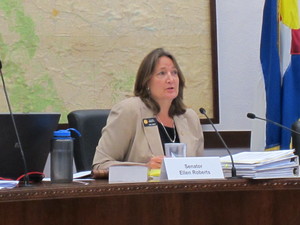It has been nearly four months since the draft state water plan was submitted to Gov. Hickenlooper in December, and that only after an extensive education and outreach campaign. A campaign that will continue throughout the year leading up to the finalization of the plan, and beyond.
 Since December, the Colorado Water Conservation Board (CWCB) has received more than 2,000 comments, and more continue rolling in. From the January 2015 issue of Headwaters magazine:
Since December, the Colorado Water Conservation Board (CWCB) has received more than 2,000 comments, and more continue rolling in. From the January 2015 issue of Headwaters magazine:
To date, the CWCB alone has met with more than 100 organizations, agencies and partners to solicit input. In its first 12 months, the coloradowaterplan.com website’s page views climbed to 18,500. As of October 2014, when the public comment period closed for the plan’s first draft, more than 13,000 individual comments on the plan had been received by the CWCB, whether delivered via the website, by mail or email, or verbally at a meeting or hearing. Every comment was acknowledged and received a response.
Coloradans voice their input at the joint roundtable meeting held in December 204 in Grand Junction.
The roundtables, too, received hundreds of comments as they developed their Basin Implementation Plans. Using local newspapers, websites, social media, radio, videos, postcards and fliers, and email lists, the roundtables worked to reach a wide audience and encourage attendance at meetings.
Numerous interest groups rallied the members of their organizations and communities to submit input. Business leaders from Protect the Flows, a coalition of 1,000 businesses whose tagline reads “The Business Voice of the Colorado River,” testified at legislative hearings held during summer 2014 and later at CWCB board meetings. “That’s a huge commitment for a businessperson,” says Molly Mugglestone, Protect the Flows co-director. “But we’re seeing that they really do have passion for this and they really do want this water plan draft to reflect their values.”
Those hearings conducted by the state legislative interim Water Resources Review Committee on the water plan during summer 2014 also reached people who might not otherwise have been heard. Senate Bill 115 directed legislators on the committee to travel the state basin by basin soliciting public comment. “The intent was to give concerned citizens not necessarily directly involved a greater voice,” says former state Rep. Randy Fischer. Many of the meetings were well attended and resulted in pages of public comments. But others lacked strong attendance. “Despite our best efforts, my sense is the general public is underrepresented in the process,” Fischer says.
Rep. Fischer is not the only one to see the general public as not fully engaged. In the latest episode of Connecting the Drops, Sen. Ellen Roberts echoes that thought:
I think that’s the challenge that we saw here at the legislature, the Governor and the executive branch of the Colorado government has done a lot of outreach but it’s a topic that most people…all they really care about is when they get up in the morning does water come out of the shower, can they make their cup of coffee or cup of tea?
 And well, if you live in Colorado, then Colorado’s Water Plan applies to you. Don’t worry, it’s not too late to be heard! All public input received by September 17, 2015 will be considered and incorporated in the final water plan. Check out the timeline to the left to see your deadlines. Additional tips:
And well, if you live in Colorado, then Colorado’s Water Plan applies to you. Don’t worry, it’s not too late to be heard! All public input received by September 17, 2015 will be considered and incorporated in the final water plan. Check out the timeline to the left to see your deadlines. Additional tips:
- Be specific General comments help your legislators and those writing the plan understand how many people are concerned about a particular issue. However, specific thoughts, particularly those based on the ideas presented in the draft, will more significantly influence the content of the final plan. The CWCB suggests framing your input by reading and reacting to or adding suggestions to the plan. Find the draft at www.coloradowaterplan.com under “resources.”
- Get involved locally Work directly with your basin roundtable. Roundtables meet regularly, and the public is invited—and encouraged—to attend.
- Put in some face time CWCB staff will take the plan on the road and continue reaching the unengaged; there is an opportunity for public input at each CWCB board meeting; and the state legislature’s Water Resources Review Committee will convene a public meeting in each basin before November 2015.
-
Sen. Ellen Roberts
Know your elected officials Do you have a relationship with your state senator and representative? Get to know them and make sure they know what issues are important to you. “We [state legislators] represent our districts but we also represent the entire state of Colorado,” says state Sen. Ellen Roberts. “It’s really helpful if the public, anyone who’s interested in this issue, touches base.” Regardless of your political party, how you cast your vote, and how much prior knowledge you have about the water plan, Roberts suggests contacting your legislators to make sure they know that water, your basin, and Colorado’s Water Plan matter to you, their constituent.
- Collaborate Whether you have a particular area of expertise or don’t feel that you have time to review Colorado’s Water Plan yourself, consider linking up with an interest group or organization that represents values similar to your own. There are many across the state. Your support will help their employees or volunteers comment in your stead, or your expertise and involvement could help round out their existing efforts to influence the plan’s balance of priorities
- Communicate with others Register for a free webinar April 28, 2015 to dig into the water plan and hear how you can communicate and interpret the draft plan and prepare for the public comment periods. Perhaps you’ll encourage others to get involved!



 Print
Print
Reblogged this on Coyote Gulch.